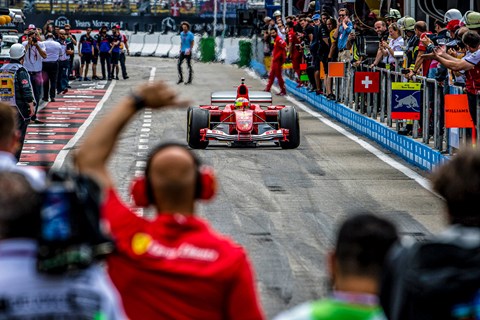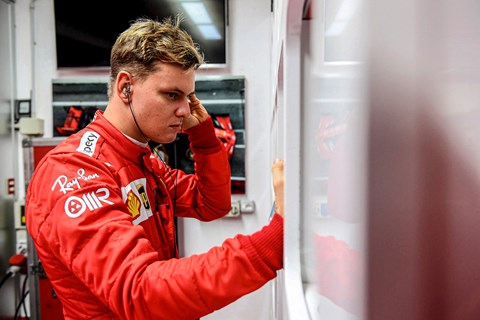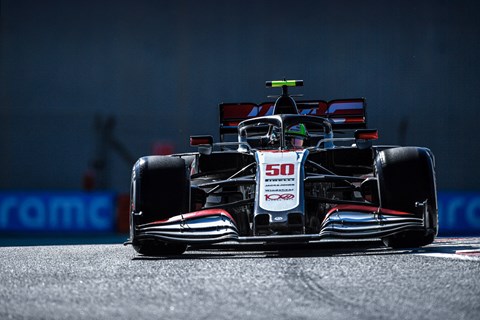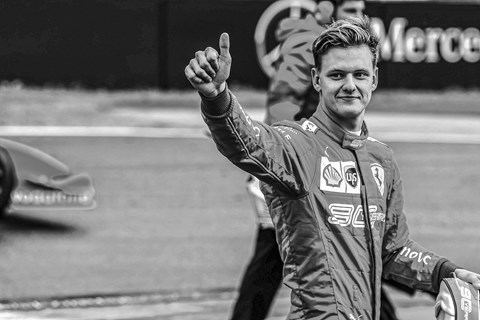► CAR interviews Mick Schumacher
► The iconic name returns to F1
► ‘Mick has the talent and the intelligence’
He’s a chip off the old block. Listen to him talk or watch him walk and you’re immediately reminded of his father. The enunciation is similar, as is the purposeful gait, and they even share the same blonde highlights. But what kind of racing driver is Formula 1 going to get when Mick Schumacher, youngest of Michael’s two children, makes his debut with Haas this season?
In short: a very good one. Mick’s a hustler. He likes to have the car moving around beneath him and he’s fast, both in qualifying and in races. He’s won all of the major championships he contested on his way to F1, including Formula 3 (2018) and Formula 2 (2020), and he’s good at reading the pace of a race. He knows when to push and when to conserve his tyres, a skill that will serve him well in this ongoing era of heat-sensitive Pirelli rubber.
But none of this will come as a surprise. Mick’s father is arguably the greatest racing driver that ever lived, and Mick’s talent has been meticulously nurtured from the outset. While most of us were learning to walk, Mick was learning to drive. He began karting at the age of two and motor racing has been his focus ever since. He’s tried other sports, such as ice skating, football and horse riding, and he’s been good at them, but they are just hobbies.
Off-track, Mick’s racing career has been steered by the brilliant Sabine Kehm, who first worked with Schumacher Snr in 2000 and who knows the motor racing landscape better than most. And if that wasn’t enough to lay the foundations for a successful F1 career, add Ferrari into the mix. They’ve given Mick access-all-areas support since he became a member of the Ferrari Driver Academy in 2019, helping him to understand the depth and complexity of F1.
In many ways Mick’s junior career echoes that of Lewis Hamilton, who was nurtured by Ron Dennis and McLaren. Lewis entered F1 in 2007 so well prepared and so comfortable in the car that he overtook his team-mate Fernando Alonso around the outside of the first turn at the opening race in Melbourne, and went on to score nine podiums in the opening nine races.
The big difference is the surname. Before Mick even starts in F1, he has to deal with the shadow of his father. The German media in particular makes endless comparisons between father and son and it’s a pressure he’ll either embrace or shun, as Jacques Villeneuve did – he flatly refused to talk about his father Gilles when he entered F1 in the mid-’90s.

‘What my dad did in F1 was extraordinary,’ says Mick. ‘I realise that more and more every day. I get told lots of stories about him by people and it makes me very proud to be bringing the Schumacher name back to F1. It brings pressure, of course it does, but that pushes me. That motivates me. I see only the positives in being a Schumacher in F1.’
The Schumacher family – and Sabine – tried hard to protect Mick early in his career. While karting he used his mother, Corinna’s, maiden name of Betsch and only swapped to Schumacher when he stepped up to single-seaters in 2015. Even then, it was only in his second season of F3, in 2018, that the Mick Schumacher bandwagon gained meaningful momentum. He won 18 races en route to the title and began to make a media profile of his own.
‘He’s magnificent at racecraft and he understands perfectly the first lap of a race,’ says Rene Rosin, the boss of the Prema team, with whom Mick won his F3 and F2 titles. ‘He’s an impressive driver; he tries to understand all of the little details and he will dedicate all his time and effort into having a good first season in F1.’
There is a lot to learn in F1 and it hasn’t been made any easier by Covid restrictions limiting travel to Haas HQ in Banbury. But Mick’s a detail man and he’ll relish trying to understand how F1 cars can be, on average, six seconds per lap faster than F2. He’ll delve into the data remotely and he’ll learn what the steering wheel’s 25 buttons do before he even holds it.
‘There’s a lot to learn, which is why every lap counts in testing,’ he says. ‘The details are endless. Even the seat becomes more important in F1 than in other formulas because the g-forces are higher and the races are longer, so you need to take great care with the seat fit. It needs to fit you perfectly because any aches and pains will be exaggerated.’

Mick and I talk on the phone as he travels to Maranello to test a 2018 Ferrari. The Scuderia are helping his preparations because there’s very limited pre-season testing in contemporary machinery. Mick will get only a day and a half in the Haas ahead of Bahrain’s season-opener, so he’s going to Fiorano to get an extra 100-odd laps under his belt in a two-year-old car, which is permitted under the regulations. It’s the first time he’s tested at Fiorano, and he can’t wait.
‘Maranello is such a special place,’ he says. ‘I’ve been there many times, of course, with my dad, and to watch cars testing at Fiorano is different to most places because you can get so close to them. To be driving there myself is going to be something else; I’m very excited.’
There are many people still working at Ferrari who remember Mick’s dad, not least the team principal, Mattia Binotto. He was Michael’s engine engineer 25 years ago and he tells a wonderful story of how Michael asked to get Turn 1 at Fiorano changed after his first test at the track because he didn’t like it! Mick will focus more on himself, of course, and Binotto will be watching closely. Mick could be the next Ferrari race driver.
These laps will be Mick’s first in a racing car since the Abu Dhabi Grand Prix in December, where he drove in first practice for Haas.

Aside from the obvious emotions of driving a Ferrari at Fiorano, he’s looking forward to the sensations of driving a car on the limit again.
‘I get goosebumps when I think about it,’ he says. ‘To be on the limit is an amazing feeling and it’s hard to describe how it feels to someone who’s never experienced it. I suppose it’s a bit like watching a really great scene in a movie, but you’re actually living it. It’s breathtaking.’
Mick’s love of racing stems not only from his love of driving, but also from a love of competition. The desire to beat others. ‘I’m a sore loser at anything – even backgammon. If I get beaten, I’ll practise and practise until I get better and can beat that person.’ Remind you of anyone?
Just don’t expect miracles in year one. Mick’s debut season will be very different to Michael’s 30 years ago. Mick won’t have a car capable of qualifying seventh on his debut, as Michael did at Spa in 1991, and he’s very unlikely to get poached by a front-running team ahead of his second race, as Michael did by Benetton. The Haas VF-21 is a modified version of the car that finished ninth in last year’s constructors’ championship, scoring only two points finishes.
Mick was 18th fastest when he drove it during FP1 in Abu Dhabi. He was 2.8sec faster than stand-in Haas driver Pietro Fittipaldi – himself only in his second grand prix – and that’s the level of the car. Mick will be forced to learn about F1 from the back of the grid and his results will be shaded by fellow F2 graduate Yuki Tsunoda, whose Alpha Tauri won last year’s Italian Grand Prix in the hands of Pierre Gasly.

The only thing Mick can do is consistently put away his new Russian billionaire team-mate Nikita Mazepin and shine when track conditions allow, such as when it rains. If he does that, the right people in the front-running teams will take notice. Most already have.
‘Mick has the talent and intelligence to make it to the top and to win races,’ says Mercedes team boss Toto Wolff. ‘He can even compete for championships. I’m looking forward to seeing what he can do.’
As are we all. The Schumacher name isn’t only back in F1; it’s back where it belongs.